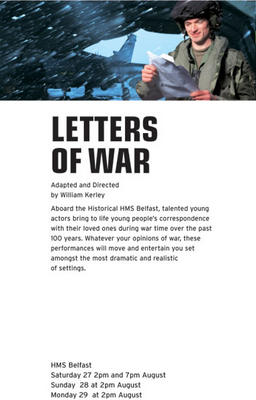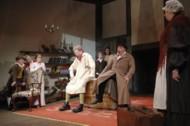Programme Piece on Violence in Theatre commissioned by Hampstead Theatre - published April 2005 - (3 months before the tragic events of 7/7/05)
 Edward Bond: ‘I write about violence as naturally as Jane Austen wrote about manners. Violence shapes and obsesses our society, and if we do not stop being violent we have no future. People who do not want writers to write about violence want to stop them writing about us and our time. It would be immoral not to write about violence.’
Edward Bond: ‘I write about violence as naturally as Jane Austen wrote about manners. Violence shapes and obsesses our society, and if we do not stop being violent we have no future. People who do not want writers to write about violence want to stop them writing about us and our time. It would be immoral not to write about violence.’These words inspire a scary little retrospective. I’ve been attempting the mathematics of brutality, by adding up the number of violent acts I’ve witnessed.
Here goes. An audit of fear: I’ve seen beatings, kickings, stabbings, garrottings, gassings, throat-slashings, electrocutions, shootings; suicide and self-harm; torture, cannibalism, the stoning of a baby, a red-hot Stratford-skewer up Simon Russell Beale’s backside - and many other atrocities; courtesy of Sophocles, Shakespeare, Marlowe, Lorca, Treadwell, Bond, Dorfmann, Barker, Buchner and Kane.
I recall the countless dead bodies, in domestic or street scenes, work-place or battlefield; corpseless heads and headless corpses; I’ve witnessed the blinding of an old man called Gloucester (numerous times) and seen a royal prince, in a darkened room above a Notting Hill pub, have his genitals barbecued and his innards ripped out by a vulture. His response at the time was this: ‘if there could have been more moments like this.’
So - that’s violence in the theatre. And I’ve seen a surfeit of violence in photographs and on screen.
But how much violence have I seen in my fortunate and sheltered real life? Mercifully little. I’ve never even seen a dead body. In my forty years outside the theatre I’ve been lucky enough to witness very few violent acts. But of the real-life violence I have seen, the pointless corporal punishment, the drunken brawling, the over-zealous arrests, the futile lashing out; none of it has made much sense to me.
In real-life I’ve seen it many times, but never once, on the stage, have I seen senseless violence.
I sat in on a university seminar the other day, and heard a talented teacher confront one of his students who drew a parallel between witnessing a murder compellingly portrayed by Lorca and the experience of driving past a motorway crash and ‘having to watch’. She implied that there was a some generalised positive lesson to learn from rubbernecking on the M4.
The teacher was agitated; for him there was no useful comparison between the two experiences, one was art, he said, created to carry a message, the other prosaic misfortune: regrettable reality. He’d seen stage dramas full of murders, death and destruction; such works could be cathartic, educative, moving - even uplifting. But never once had he found a constructive lesson in witnessing a real-life tragedy.
It’s election time. Our parliamentary representatives are suddenly interested in us, they need us off couches and fences on 05.05.05, on our feet en route to the Polling Station. No negative campaigning is the boast: but, particularly post-9/11, fear is a refined political tool. We live in a frightening world, they tell us, a violent, unstable world; they play to these fears with promises of greater sanctions for unstable or violent members of society.
Each party prides itself on a portfolio of authoritarian pledges. The terrorist threat is ubiquitous, unpredictable, army tanks patrol Heathrow, evacuation plans are published. Protect and Survive (Mk II). The politicians promise ASBOS and electronic tagging, stiffer sentences, more prison-building. And to protect us from violent foreigners, our political masters take us to regime-changing conflict in someone else’s country.
And always, when a government wants to sanction violence, it does so by appropriating the vocabulary of the artist: Basra and Baghdad become Theatres of War.
So what scares you? Being murdered in your bed by an masked intruder? A terrorist act on the tube? The threat of violence which takes away your freedom of speech?
Some violence is misdirected passion, some is borne of fear. The violence that shuts down a theatre is the latter.
In our second city last December, a cumulative threat of violence became a virtual mob-rule and cancelled performances of a play. The Lord Chamberlain’s purple pencil has, in our times, become a brick-throwing gang who stay outside the theatre: they have no desire to enter the building and become audience members.
Perhaps only a couple of this mob have actually read the text of the play.
But a play-text is not a play, any more than a designer’s model constitutes a theatre set. A play only truly becomes itself in performance, in being acted before and audience who are prepared to watch, to listen and to think.
A theatre devoid of provocation, a theatre bowdlerised of violence; like Nahum Tate’s 1681 evisceration of KING LEAR, which ends with Lear not dead but restored to the throne - and the happy marriage of Edgar to an un-hanged Cordelia; this is an unchallenging theatre with an attenuated, atrophied voice.
As long as the theatre challenges and provokes, shows us conflict to which an audience can add its imaginary puissance and draw its own conclusions, a theatre which presents violence which is never pointless; we’ll leave the auditorium able to paraphrase the dying Hippolytus in Sarah Kane’s 1996 masterpiece PHAEDRA’S LOVE: ‘if only there could have been more plays like these’.






